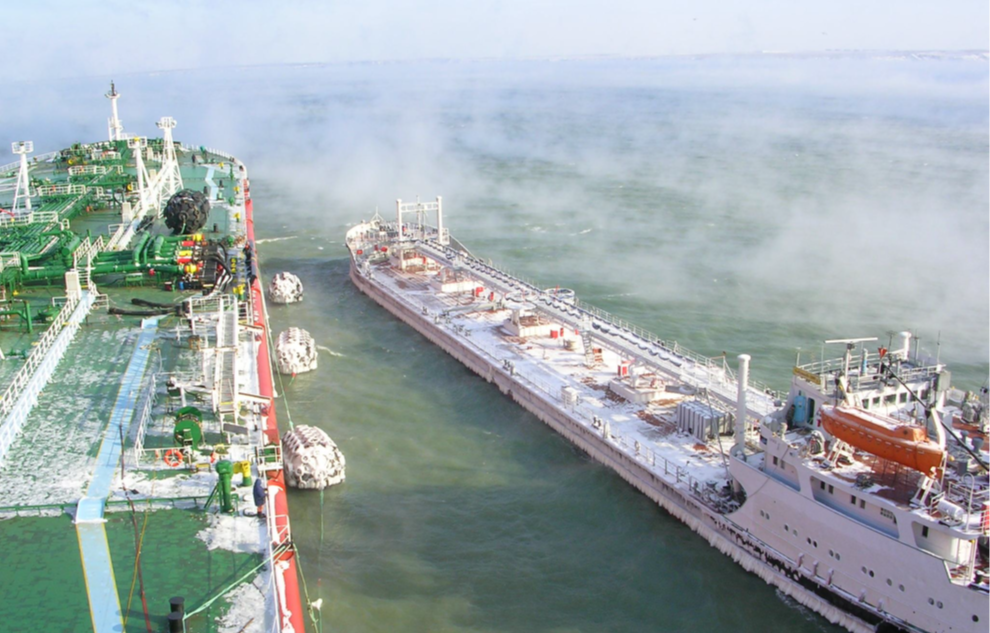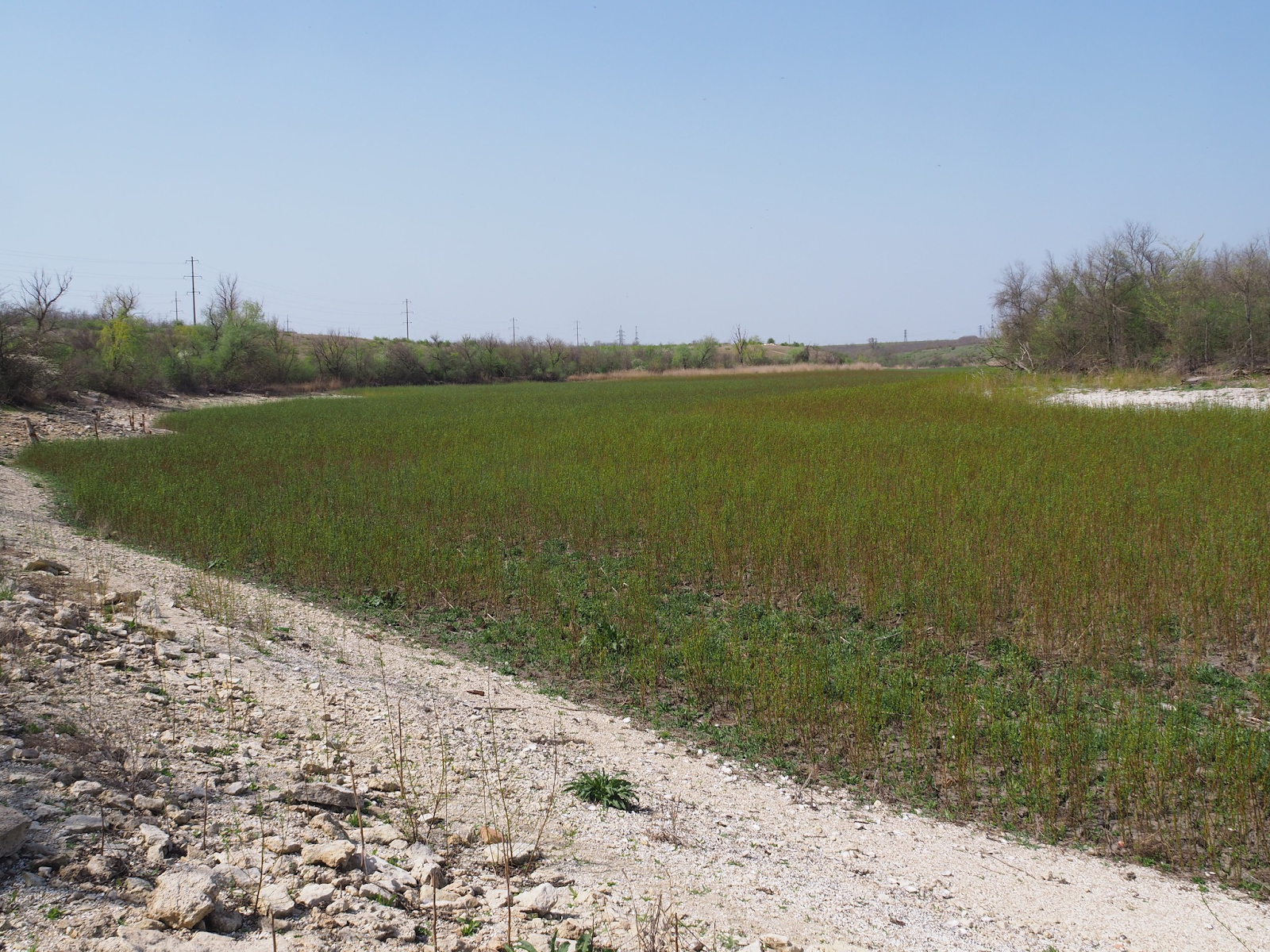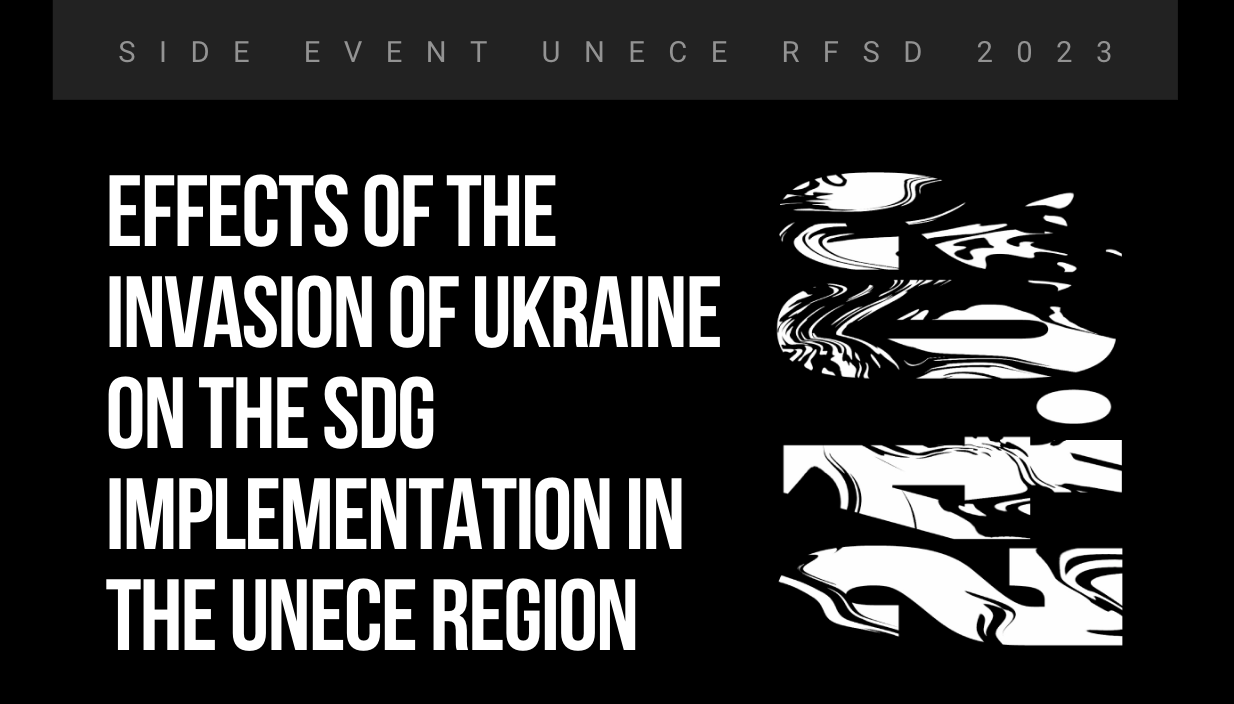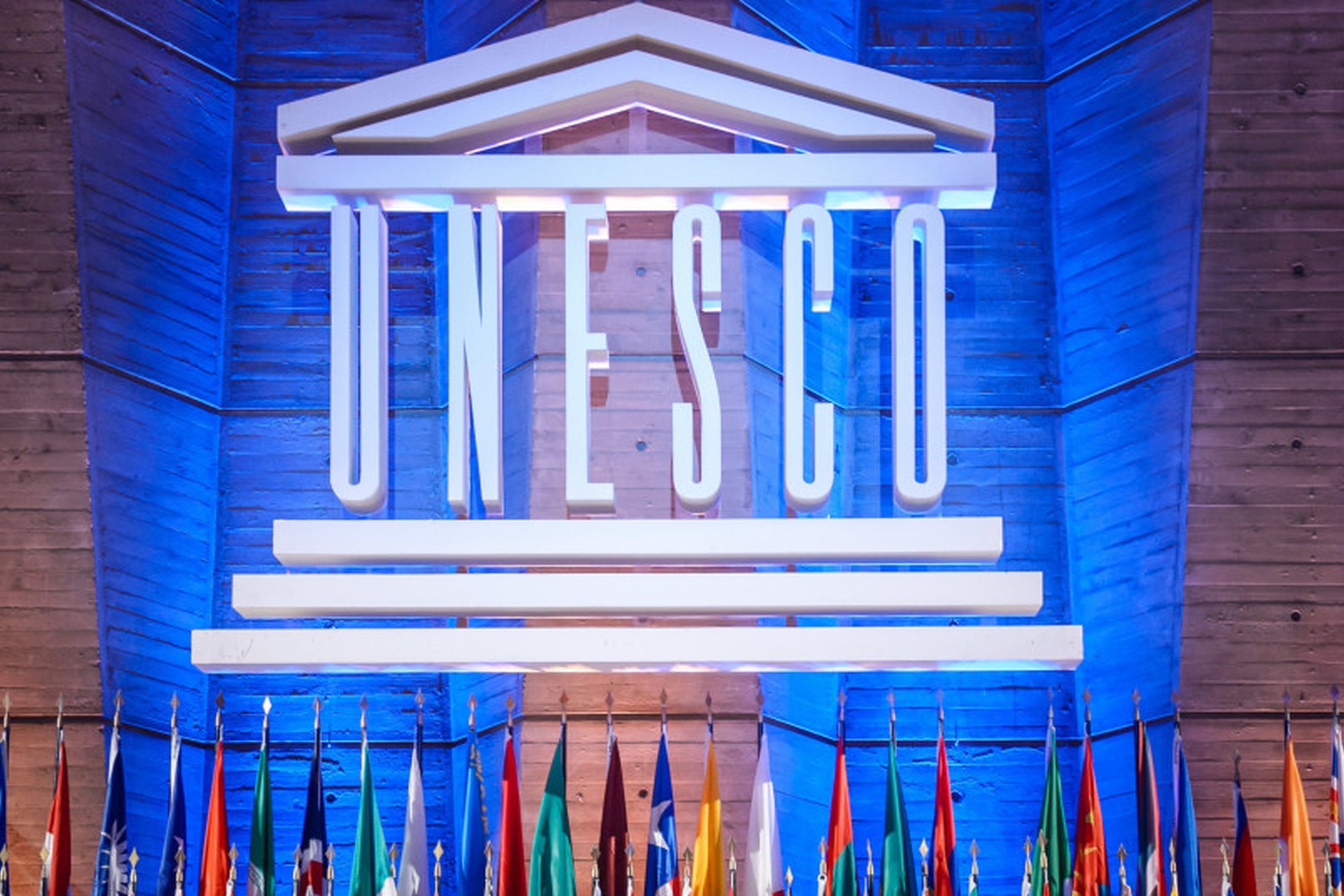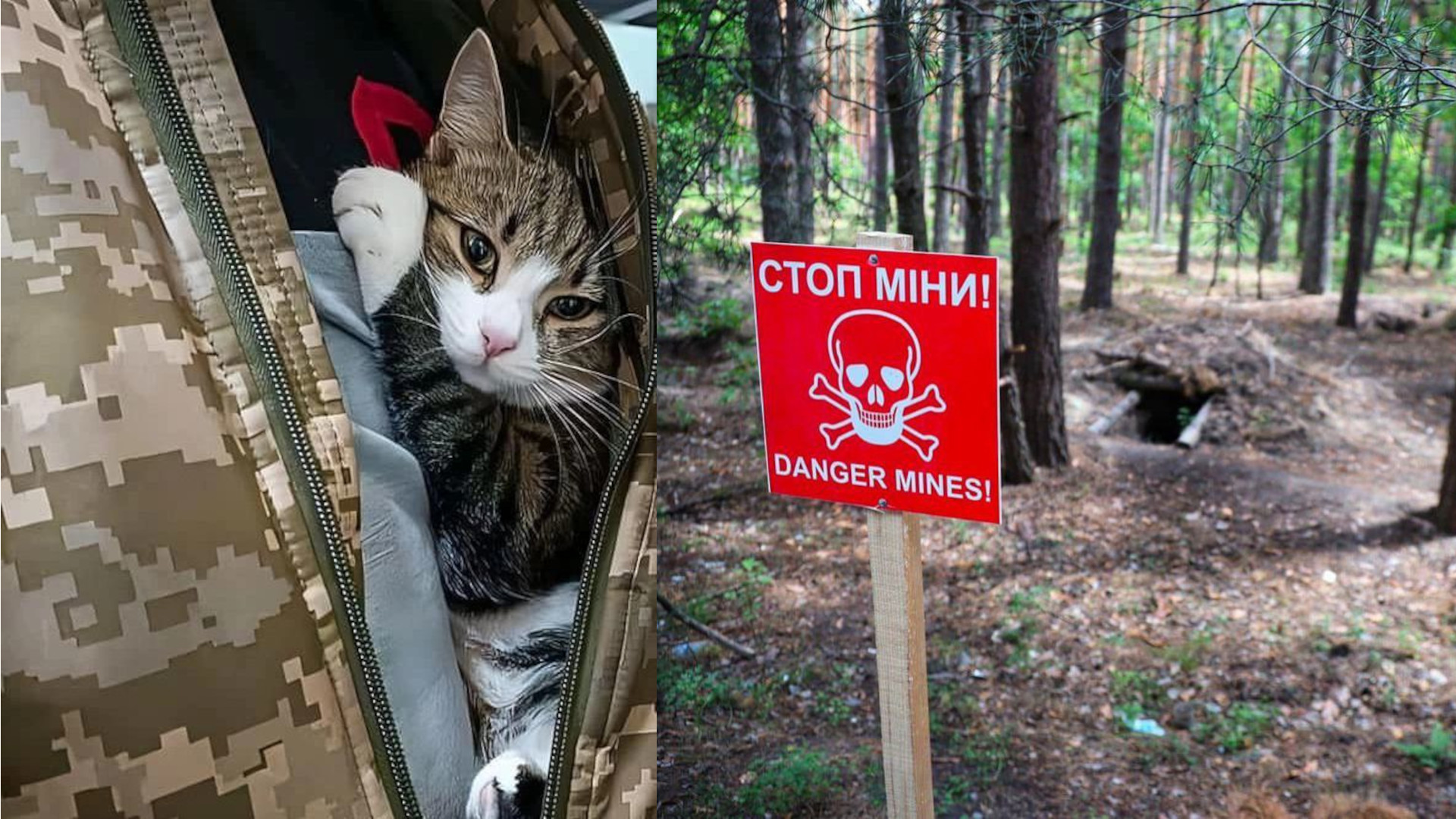Eugene Simonov
Pollution of marine waters and coastlines with oil and oil products is one of the most serious threats to Black Sea ecosystems, threats which have been significantly exacerbated by the war. On December 15, 2024, two Russian tankers broke in half during a storm in the Kerch Strait, spilling between 2,400 and 8,500 metric tons of heavy fuel oil (a regional blend known as mazut) intended for export to India. This article analyzes the circumstances and causes of the accidental spill, including in the context of a “shadow fleet” operation facilitating the export of oil products.
Although study of the oil spill and the spill response are aggravated by the military situation, the Russian government’s chronic negligence is the root of the disaster with a power structure that is unable and unwilling to learn from its own mistakes. Nevertheless, if the international community were to implement strict environmental monitoring of the shadow fleet that is exporting Russian oil and oil products, the risks of similar spills in the near future could be significantly reduced.

History of chronic oil pollution in the Black Sea
This is not the first time oil pollution has occurred in the Kerch Strait and the adjacent waters of the Black and Azov seas. Quite the opposite, in fact: such oil product pollution has been a chronic occurrence since long before the start of Russia’s full-scale invasion of Ukraine.
Conducted between 2017-2021 by ScanEx and Russian Academy of Sciences institutions, a five-year study used 460 Sentinel-1A imagery to detect oil slicks on the sea surface in the Kerch Strait area. The study identified 2,599 film pollution spots covering a total area of 1,107 sq km. The spills were found mainly in (in order of decreasing size) road mooring transshipment areas in the strait, the port of Taman with its mooring complex, and road/anchorage areas at the entrance to the strait in the Azov and Black Seas. In addition, naturally-occurring oil seeps were discovered in the strait, adding a natural baseline that must also be considered.

The most important driver of increasing pollution is the expansion of transport routes, primarily due to increased shipping intensity. According to 2019 Rosmorrechflot data, over 20,000 ships pass through the Kerch Strait alone each year, mostly cargo ships. Russia, Azerbaijan and Kazakhstan use the Black Sea to export oil and oil products. In the calendar year of 2024, cargo turnover at seaports controlled by the Russian Federation in the Azov-Black Sea basin totaled 254.2 million metric tons, including 133.1 million tons of ship-to-ship transfers of liquid cargo, largely oil and oil products.
Ship-to-ship transfer of oil products is a dangerous operation, often associated with significant oil spills. In general, pre-war oil pollution in the Black Sea exceeded standard indicators (maximum permissible concentration) by 20-80 percent, with the Kerch Strait experiencing the worst conditions. This is not surprising, given that the very narrow strait and its powerful water currents form a dangerous bottleneck between the two seas.
This situation was aggravated by construction of the Crimean Bridge across the strait in 2015-2019, further narrowing the channel. Most of the bridge is built on a causeway into the sea, with small passages left for ships and water flow. Completion of Russia’s “project of the century” narrowed the natural “bottleneck” even further, and today ships must also maneuver past bridge supports.
Read more: Crimean Bridge: Environmental impact of Russia’s ‘project of the century’
As severe as chronic marine oil pollution is, the problem can be exacerbated by major oil spills resulting from shipping or industrial accidents. Tankers carrying heavy oils or mazut occasionally wreck and sink, creating the potential for future leaks and spills from sunken ships. Although shipping accidents account for only about ten percent of all ocean oil pollution, each catastrophic spill poses a significant threat to marine and coastal ecosystems.
In a 2020 interview, Sergei Stanichny, head of the Department of Remote Sensing Methods at the Marine Hydrophysical Institute (Russian Academy of Sciences), explained that water is cold at great depths, causing oil products (such as mazut) to become viscous and heavy and settle on the bottom. But the water in the Black Sea has been gradually warming for many years, and while until recently water temperature stood at +7-8˚ C at a depth of 50 meters, the temperature today can reach +15˚ C.
According to pre-war data published by Oktagon.Media, approximately 800 military, passenger and industrial ships rest at the bottom of the Black Sea today. These vessels could become future sources of pollution due to the heavy oil products still on board. Hastened by corrosion and water currents, sooner or later mazut will leak out of ship hulls and pollute the seafloor, from there rising into the water column and fouling coastlines during bad weather or warming.
Impact of war on pollution of the Black Sea
With Russia’s seizure of Crimea, its military and civilian activity in the area has increased, further worsening oil pollution in the Azov Sea and Black Sea.
Oil spills are clearly visible in satellite images made available in a review of the environmental consequences for marine ecosystems published by the Conflict and Environment Observatory (CEOBS) and Zoi Network. In one case, the spills resulted from missile attacks on ChernoMorNeftegaz drilling platforms in June 2022.
Risks posed by wrecked ships have also increased, with roughly 100 additional ships, military and civilian, sinking or damaged since the war began. For example, evidence of a limited oil spill was visible from space at the site where the Moskva military cruiser sank. Most of its fuel reserves, which may exceed 2,000 tons, are probably still stored in its fuel tanks at a depth of 50 meters—a huge risk for the future.



A mazut leak (red slick west of the Crimean Peninsula) originating from the sunken Moskva military cruiser. Source: Pravda_Gerashchenko Telegram channel
According to Sofya Sadogurska, a climate expert at the Ecoaction Environmental Initiatives Center in Ukraine, the oil slick resulting from ships sunk in 2022-23 has covered tens of thousands of square kilometers of Ukraine’s marine protected areas, including the Snake Island National Zoological Reserve, Zernov Phyllophora Field National Botanical Reserve and the Black Sea Biosphere Reserve (National Academy of Sciences of Ukraine).
Read more: Impact of Russia’s invasion of Ukraine on the Black Sea and the Sea of Azov
Russia’s shadow fleet—a potential environmental threat
Perhaps more than anything else, today’s threat of marine oil pollution caused by the war in Ukraine lies with the “shadow fleet”—oil tankers that freely export Russian oil sold at prices above the ceiling set by the G7 sanctions and the Western governments that have joined them.
The radical reduction in pipeline oil purchases by European countries forced Russia to increase oil shipments by sea to reach other buyer-countries. Fearing that a direct block on Russian oil and oil product exports by sea could have adverse consequences for the global economy, Western governments created a complex sanctions regime for hydrocarbon fuels. The strategy involves the introduction of a $60 per barrel price cap on the purchase of Russian oil, a policy designed to limit Russia’s ability to finance the war without limiting the actual purchase of oil and its derivatives. Under this regime, oil tankers attempting to circumvent sanctions would become uninsurable and blocked from servicing in ports of call, practices seen as powerful leverage against the regime.
Read more: An environmental perspective: Are sanctions against Russia working, and if not, why not?
In response, Russia has assembled a “shadow fleet” of more than 1,000 tankers sailing under a variety of flags, a fleet of worn-out vessels individually registered to tiny shell companies that typically operate the ships in violation of regulations and that are sometimes uninsured by Western insurers. When carrying Russian oil, these ships often conceal their destination ports and routes. In the event of an accident, a small company possessing only one vessel has absolutely nothing to seize; it goes bankrupt without a hitch, avoiding any liability.
Greenpeace counted a 70 percent increase in tankers off the German Baltic coast in 2024 over pre-war numbers. Greenpeace and many other environmental organizations agree that the shadow fleet poses a serious environmental threat, given that the use of aged ships can lead to oil leaks. Moreover, their owners are not able to be held liable for damage. With a company registered to a post office box in Seychelles, no one bears responsibility for environmental damage.
At the same time, there is still insufficient direct evidence regarding the shadow fleet’s negative consequences for marine ecosystems. A review of tanker leaks around the world, published in October 2024 by Politico, lists just nine examples of oil spills likely associated with the shadow fleet (shown in the map below).

By the end of 2024, the US and other Western countries had tallied a list of a scant 200 vessels believed to be violating the sanctions regime, just one-fifth of the potential violators in the shadow fleet. The challenge is that, in order to impose sanctions, convincing evidence must be assembled for each vessel believed to be in violation.
Ukrainian security services maintain a special sanctions website that already lists 570 shadow fleet vessels. In September 2024, Greenpeace compiled a list of 192 tankers that have not yet been sanctioned and that threaten the Baltic Sea ecosystem.
On the eve of the recent disaster in the Kerch Strait, the international community fearfully awaited a major oil spill. They were seriously concerned that the introduction of oil sanctions in the absence of sufficient mechanisms for their widespread application de facto increased the environmental risks of maritime oil transportation.

2024 catastrophe, déjà vu?
On December 15, 2024, two small river tankers located at the southern anchorage at the exit from the Kerch Strait awaited transshipment to a large sea tanker. Both were caught in stormy weather and broke in half. On the Volgoneft-212, which sank completely, one sailor died from hypothermia and exposure, but the remaining 12 crew members were rescued. The stern half of Volgoneft-239, which also broke apart during the storm, managed to approach the shore and run aground 80 meters offshore. The entire crew was rescued.
According to various estimates, between 2,400 and 8,000 metric tons of mazut originating from the Saratov Oil Refinery spilled out of the damaged tankers into the sea (in January 2025, the Marine Rescue Service described the mazut as the M-100 blend).
Mazut is a toxic, viscous black blend – the remaining residue after all useful light fractions (gasoline, kerosene, gas oil) have been distilled from crude oil.
The ships were also each carrying 25 tons of diesel fuel, a substance even more toxic than mazut to aquatic life.
Another fuel oil tanker, the Volgoneft-109, developed a crack in its hull but managed to send a distress signal and was moved to a safe location.
This spill disaster literally duplicated (while exceeding the scale of) the previous largest pollution of the Kerch Strait in the 21st century, an event which occurred on November 11, 2007, under approximately the same circumstances. While waiting to offload its cargo, a sudden storm caught tanker Volgoneft-139 by surprise and it sank, along with its mazut cargo. At the time, the authorities failed to delve into the systemic causes that led to the spill, summarizing the cause as “abnormal weather conditions.”

What was the destination of the sunken tankers’ mazut?
On December 19, 2024, the fourth day following the disaster, and during the traditional, annual “Direct Line” broadcast, President Putin gave a clear indication of where to look for those responsible for the disaster in the Kerch Strait: “First of all, this is, of course, an environmental disaster. This is completely obvious. Law enforcement agencies are assessing the actions of the ship captains.”
The president continued, “They report to me that, in their opinion, the ship captains violated relevant rules and did not seek shelter in a timely fashion. Some ships did reach shelter, and everything is fine with them. But those [two] did not leave, and they did not anchor where they were supposed to. Let the relevant services—both the Ministry of Transport and law enforcement agencies—deal with this.” In saying this, he seemed to preemptively anticipate and limit the results of the investigation into why and how the déjà vu disaster happened.
Promptly after the sinking, pro-government Russian analysts immediately expressed concern that such accidents could be used to discredit the Russian fleet and oil exports.
As National Fund for Energy Security director Konstantin Simonov noted on the pages of Rossiyskaya Gazeta: “If they wanted, of course, the US and the EU could latch onto this accident. But in reality, if we look at things objectively, this story has nothing to do with the tanker fleet. Firstly, these were Russian tankers. Secondly, they were transporting oil and oil products within Russia; the ships were not intended for international trade.”
Digging deeper though, it is clear that the mazut being transported was intended for export. Most likely, it was destined for Indian oil refineries, which are increasing their purchases of mazut from Russia for the production of diesel fuel and other products.
Reputable websites analyzing the disaster cite credible evidence that both Volgoneft-212 and Volgoneft-109 were supposed to transfer cargo to crude oil tanker FIRN (known as SCF CAUCASUS until 2021, and then Bear Alcor until July 2023). Commissioned by Russia’s Sovcomflot, the vessel was built in a South Korean shipyard in 2002 and sailed under a Liberian flag. In pre-war 2021 it was seen transporting sanctioned Venezuelan oil. In early 2023, the vessel garnered international attention as an example of delivering Arctic oil from Murmansk to India shortly after sanctions were imposed on Russian oil. In October 2023, an offshore Seychelles company purchased the vessel, sailing it under the flag of Panama. FIRN appeared on the prestigious Lloyd’s Register at the end of 2022.

In 2023-24, Equasis data showed that the tanker made several voyages from Baltic and Black Sea ports to Indian oil refineries. Ukraine’s Main Intelligence Directorate, Greenpeace and the monitoring group Black Sea Institute of Strategic Studies have all included FIRN in lists of shadow fleet vessels.
Aside from being listed on Lloyd’s Register, which is unusual for a shadow fleet vessel, the remainder of the ship’s history is very similar to hundreds of other tankers exporting oil despite sanctions. The ship is operated by a tiny Indian management company that also has an identical crude oil tanker, the NEVE, at its disposal. Owned by another Seychelles firm and undertaking similar voyages, this ship also changed flags and names at exactly the same time as the FIRN. NEVE is currently en route from the Indian port of Vadinar to Novorossiysk.
On October 15, 2024, FIRN served as an “oil product storage tanker” during training exercises conducted prior to approval of STS TRANS LLC’s oil spill prevention and response (OPR) program for offshore transshipment practices in the Kavkaz seaport. Rosprirodnadzor employees participated in the work of a commission evaluating the results of the exercises, which were considered satisfactory. Earlier, on March 7, 2024, Rosprirodnadzor approved a positive conclusion of the state environmental review on the “Justification of the economic activities of STS TRANS LLC for the transshipment of oil, oil products and chemical products in bulk within the boundaries of Section 2 and within the boundaries of Section 3 on the territory of Kavkaz seaport.” Thus, in 2024 the agency responsible for environmental oversight twice approved ship-to-ship transfers in the location where the catastrophe subsequently occurred.
In early January, the FIRN remained at a southern anchorage in the port of Kavkaz, not far from the main area for ship-to-ship transfer of oil products, the same area where similar tankers SANAR-7, SANAR-8, BORAY and other ships specializing in ship-to-ship transfer of oil for export were located. It is most likely that FIRN was specifically chartered as a storage tanker to support transshipment and export operations.
From the day of the accident until the end of 2024, at least seven to 14 additional Volgoneft series tankers (e.g. 150, 141, 109, 114, 267, 147 and 266) were in the Kerch Strait, Black Sea and Azov Sea and were likely headed to Kavkaz port carrying mazut for transshipment and export. The tanker Prikamye (formerly known as Volgoneft-55) managed to transfer its cargo to FIRN and make it to shelter before the storm. At the time of this article’s writing, FIRN is still anchored, awaiting additional loads of mazut.
Thanks to the 2007 disaster, it was understood that Volgoneft tankers, “river-sea” class vessels, are poorly suited for navigation in rough seas and cannot be operated at wave heights exceeding 2.5 meters. At present, there are approximately 80-140 Volgoneft-series vessels at sea in Russia. Most of them are rusty, old ships built in the 1970s that have completely exhausted their service life and require immediate disposal. Records show that each of them was repeatedly repaired and usually has permission to sail in clear weather as far into the sea as the port of Kavkaz.
In the registry maintained by the Russian Classification Society, Volgoneft-239’s “vessel status” is recorded as “08 – Documents suspended”, i.e., it had no permission to go to sea at all. The Russian Ministry of Transport has already acknowledged that the two tankers that sank did not have permission to be at sea after November 30. Insurance policies for both vessels had also expired in November.
In other words, their characteristics as a whole indicate that the wrecked ships are equivalent to “shadow fleet” tankers, neglecting safety requirements in order to maximize export volumes of Russian petroleum products.

Similar past accidents
The recent disaster in the Kerch Strait is not unique. Similar large mazut fuel spills have happened a number of times in the last quarter-century.
- PRESTIGE
In November 2002, the tanker Prestige broke in half and sank in the Atlantic Ocean off the coast of northern Spain during a severe storm. More than 80,000 tons of Russian mazut spilled into the ocean. At the time, the pollutant being shipped from Russia was identified precisely as “Heavy Fuel Oil No. 6; this is the same mazut that spilled in December 2024.
Pollution covered 3,000 km of coastline in Spain, Portugal and France. Ships from ten countries, including 1,000 fishing boats, participated in efforts to collect the mazut from the water before it reached the shoreline. They collected roughly 50,000 tons of oil products and oil-contaminated garbage. The shores were cleaned for many months by 300,000 volunteers from all over Europe, many of whom had health problems afterwards. In addition, 5,000 military personnel, municipal employees and hired workers took part in the cleanup in Spain. There, 141,000 tons of oil-contaminated soil were collected, mostly manually, and in France collection exceeded 18,000 tons. The most difficult part was cleaning bluffs and rocky shorelines.
By 2008, the main Spanish processing center had handled 170,000 tons of contaminated material. In total, material volume four times the amount of leaked mazut was collected and processed. Researchers estimate that 34,000 tons of oil products remained in the marine environment.
The spill is thought to have killed between 150,000 and 250,000 guillemots, fulmars, puffins, and other waterfowl and seabirds. During and immediately after the spill, the deaths of 124 cetaceans (11 species), and 90 sea turtles (two species) were documented along the coastline. Local marine zoologists estimate that on average only 14% of all dead cetaceans wash ashore in those waters. Generally speaking, the Prestige is the largest well-documented mazut spill disaster.
- ERIKA
Another example of a fuel oil spill is a catastrophic oil spill from the tanker Erika on December 12, 1999. It sank off the French port of Brest, spilling 17,000 tons of HFO into the sea. Oil products washed up on sandy beaches, rocky shores, salt marshes and into river estuaries.

An independent expert analysis showed that the tanker’s cargo was a “non-standardized mixture of petroleum products” containing significant carcinogens and other substances extremely dangerous to humans, while the export of toxic industrial waste is prohibited by EU regulations. However, the EU Environment Commissioner and other official bodies did not share this perspective, since the company responsible for the disaster mobilized many experts and the press to prove that the spill consisted of “Total’s standard heavy fuel oil No. 2” (EU equivalent of mazut). This not only freed the company from accusations of illegally exporting toxic substances, but also allowed the authorities to continue to recruit volunteers to clean up the toxic mess and even to open the “cleaned beaches” to vacationers. On the beaches, people cleaned up the mazut using shovels, collecting more than 250,000 tons of contaminated material, over an order of magnitude greater than the volume of the spill itself.
The cleanup ended in December 2003. More than 300,000 birds died as a result of the disaster. In some habitats, such as salt marshes, mazut persisted for a decade after the accident.
The Prestige and Erika oil spill disasters are covered in detail in Tim Deere-Jones’ 2016 report on the risks of heavy oil fuel spills.
- Volgoneft-248
On December 29, 1999, the Volgoneft-248 broke in half and sank with 4,300 tons of mazut on board during a storm in the Sea of Marmara, near Istanbul. The ship was built in 1975. According to various sources, between 1,500 and 3,000 tons of the mazut spilled into the sea. Five kilometers of Istanbul’s coastline, including popular beaches, were heavily polluted. Some of the oil product settled on the seafloor, and the government was forced to hire divers to collect it, since using a dredger would have harmed seafloor ecosystems.

- Volgoneft-139
The closest example is the sinking of the Volgoneft-139 tanker in the Kerch Strait during a severe storm on November 11, 2007. The vessel broke in half at anchor, the bow sank on the spot, and the stern was thrown aground on the island of Tuzla. According to official data, 1,600 tons of mazut leaked into the sea, the exact blend of which is still unknown. By all indications, it was mazut M-100. The bi-coastal cleanup took Russia and Ukraine more than a year to complete. As many as 30,000 birds died.
Following the 2007 tragedy, marine biologist Alexander Korshenko and his co-authors, commissioned by the International Black Sea Commission, an intergovernmental body implementing the Convention on the Protection of the Black Sea from Pollution, wrote a book entitled “Oil Spill Accident in the Kerch Strait in November 2007.” Intending to obtain compensation for losses, Ukraine requested assistance from UNEP and the European Union, which resulted in the publication of the “Oil Spill in the Kerch Strait: Ukraine Post-Disaster Needs Assessment” report.
The above cases are important lessons that could be very useful to the Russian authorities to more accurately assess risks, prevent disasters and better organize spill cleanup, if they so desired.

Unwillingness to learn from past mistakes
The desire and capacity of the Russian Federation to ensure the safety of oil and gas shipping has diminished substantially during this war, hostilities which are fundamentally nourished by oil exports. However, even prior to this catastrophe, environmental safety in the oil and gas shipping sector has not been a priority.
The main reason for these accidents, according to an independent environmental expert who wishes to remain anonymous, is the careless disregard of the state and all its structures, as well as big business, for environmental safety. These tragedies occur because of irresponsible individuals and organizations, as well as gaps in legislation and deliberate weakening of environmental law in recent years (especially since 2021, when the requirement for constituent regions to maintain oil spill response plans (OSRs) was abolished), corporate lobbying lowering environmental standards and procedures, and stifling of the professional environmental conservation community and the country’s news media.
Despite the harsh lesson of the 2007 spill, the Russian authorities have learned nothing and prepared for nothing. Everything that “went wrong” in 2024, was a repeat of events in 2007, as made evident by the local independent press. Furthermore, at the time of the spill in 2007 leading experts analyzed earlier accidents in detail and accused the authorities of being unable (or unwilling) to learn.
Procedures, technical capacity, and standards for the export of heavy petroleum products, if they have changed, have only increased the risk of accidents. At the same time, the fleet transporting them has aged by 17 years. Government agencies do not ensure strict compliance with existing environmental safety standards, let alone work to improve legal norms using analysis of past accidents.
Offshore transshipment— ship-to-ship transfer of oil at sea—especially fraught with oil leaks and spills, is still encouraged in every possible way. Thus, the “justification” for this activity fails to even consider the possibility of an accident with a “tanker-carrier” breaking in half during a strong storm, although this is exactly what happened in this same area in 2007. The training exercises conducted by STS TRANS LLC just two months before the 2024 disaster (noted earlier in this article) did not in any way ensure the company’s oil spill response readiness. All of this was approved by the highest oversight authority, Rosprirodnadzor.
Outdated oil refining technologies at Volga region refineries apparently also contribute to the creation of large quantities of mazut, a substance that is essentially a toxic mixture of residues from refinery processing for which there is no consumer or processing capacity within Russia. But there is demand for it at more advanced refineries in other countries. This, coupled with the lack of proper government oversight, creates irresistible incentives to continue using old river tankers that are unsuitable for sea navigation as a means of delivering mazut to export vessels waiting at sea.
This situation in Russia is an obvious anomaly in the context of global trends. According to Russian researchers, the number and volume of large oil and oil product spills during their transportation by ships decreased dramatically worldwide between 1970 and 2021. This downward trend in oil spills has persisted despite the overall increase in oil trade during the same period. Thus, in the 2010s, the total number of oil spills amounted to 164,000 tons, an amount 95% smaller than in the 1970s. The general trend of decreasing numbers and volume of oil and oil product spills is explained by the adoption of the international MARPOL convention. This convention established requirements for the double-hull design of oil tankers, development of navigation systems for ship navigation, introduction of strict national legislation, and development and implementation of multi-level OSR systems. Russia, as a leading oil power, should be at the forefront of this process, instead, it is an outsider.

The “Russian threat” of oil spills has seriously alarmed international NGOs and networks involved in the protection of ecosystems and shipping safety in the Arctic and Atlantic oceans. In particular, they have made statements and appeals aimed at drawing attention to the threats arising from Russia’s irresponsible behavior in the transportation of oil products around the world.
Dr Sian Prior, lead advisor to the Clean Arctic Alliance told UWEC, “The Clean Arctic Alliance believes that other regions would benefit from following the example of the International Maritime Organization, through which a new ban (with notable caveats) on the carriage and use of HFO as fuel in polar regions came into force in July 2024.”
She said, “The accidents in the Kerch Strait demonstrate the inability of authorities to respond to heavy fuel oil accidents even in a region where there are considerable shipping, port facilities and resources – a spill would have far worse implications in the Arctic.”
Preventive measures to avoid future disasters
It is relatively clear what Russia must do in order to prevent future catastrophes:
- Ensure nationwide implementation of all international environmental safety requirements in marine environments, requirements with demonstrated effectiveness on a global scale;
- Establish strict state oversight enforcing compliance with legal requirements by the oil and transport sectors;
- Ban aging river vessels from entering waters that pose a danger to them, and take old oil tankers out of service due to excessive risk and replace them with new, safe vessels;
- Offshore transshipment of petroleum products must be limited and equipped with technologies and control systems to guarantee safety;
- Equip the country’s Marine Rescue Service with equipment for cleaning and protecting shallow water areas during spills as well as with the technology required to detect and neutralize oil products in the water column and on the seafloor;
- Ensure coastal municipalities and regions possess realistic OSRs, necessary equipment and personnel, and sufficient capacity to dispose of oil products and rescue injured animals; and
- Create an open database on oil spills in Russia, analyze accumulated experience and introduce systemic improvements to the regulatory framework and management mechanisms to prevent future accidents.
For Russian leadership, however, these recommendations fall on deaf ears.
As long as the war rages on and the trade in oil products fuels it, no reasonable or sufficient restrictions will be made for this industry.
Thus, as pro-government oil analyst Konstantin Simonov feared, the most promising path now is to use all available international mechanisms to effectively halt the export of oil by the shadow fleet, a process that violates environmental safety standards. Ports around the world must limit the access of old tankers and their questionable owners and suspect documents and subject them to detailed inspection for compliance with environmental safety regulations. Port administrations that fail to carry out such inspections should be subject to fines and sanctions.
The December 2024 disaster is the clearest proof of the seriousness of the environmental risks of transporting oil in old vessels with murky ownership. If dangerous exports are not limited, what happened in the Kerch Strait could be repeated in any waters around the world through which the Russian “shadow fleet” passes.
The second article in the series “Military Oil Spill” will focus on the scale of the environmental catastrophe now unfolding in the Black Sea.
Note: On January 10, 2025, while this article was being finalized, the United States announced a new sanctions package that included strict restrictions on 183 shipping vessels, 150 of which are involved in the transportation of Russian oil. This move can be assessed as a significant new threat to the trade in Russian oil, one that is capable of reducing the resources available to the Russian Federation to finance its war in Ukraine. The reasoning for their inclusion in the sanctions list has no environmental component, and thus the environmental effect is not yet apparent. The “hero” of our investigation into the oil spill, the tanker FIRN, was not subjected to sanctions, but the list includes the tankers NEVE and APUS, as well as the storage tankers SANAR-7, SANAR-8, and BORAY, all of which are involved in transshipment operations at the port of Kavkaz. It falls to the marine ecology community to assess whether or not these new sanctions have reduced the environmental risks of oil spills and, if so, to what extent. Furthermore, it will only be possible to assess these effects if the incoming US president’s administration establishes strict control to force compliance with these sanctions.
Translated by Jennifer Castner
Main image: Preparation for transfer of oil products at a Kavkaz seaport anchorage Source: Temryuk Municipal Administration

